An unstable lifestyle, constant presence on the computer, lack of physical activity are now becoming more common. All of these and many other factors, of course, affect the human body, leading to a number of changes or diseases.
One of these diseases is osteochondrosis. Let's try to find out what is thoracic osteochondrosis, its type and how to deal with it.
What is osteochondrosis?
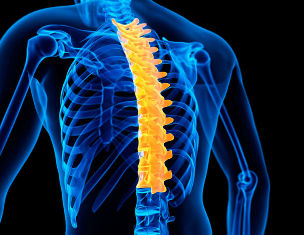
Osteochondrosisis a disease that affects the intervertebral disc and other spinal tissues. In short, the vertebrae are compressed, thus compressing the intervertebral disc.
IMPORTANT! If treatment is not taken in a timely manner, the vertebrae become less elastic and begin to bind the spinal cord. At this stage, severe swelling and pain appear.
There are four types of osteochondrosis, each named according to the problematic part of the spine:
- cervix;
- lumbar;
- dada;
- collaborative.
Patients often do not know which specialist to consult while treating osteochondrosis. It should be noted that the therapistwill refer the patient to a neurologist to clarify the diagnosis. If the case is difficult, you may need the help of a vertebrologist, a narrow specialist in the field of spinal diseases.
Osteochondrosis of the thoracic spine or thoracic constrosis
Osteochondrosis of the thoracic spine (or simply chondrosis) of the spine is a degenerative-dystrophic disease caused by changes in the intervertebral disc of the thoracic vertebra.
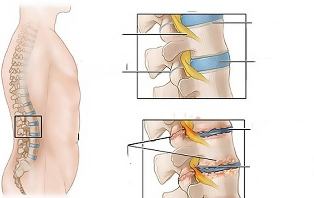
If you look in more detail, then thoracic osteochondrosis first affects bone tissue (vertebra), and with development begins to affect cartilage tissue. Thereafter, osteochondrosis can cause not only serious pain, but also other diseases, and sometimes even disability.
Let's see how thoracic osteochondrosis is diagnosed in patients. A large number of patients come with obvious signs of illness. At a later stage, the specialist can determine the exact disease with a simple examination. In other cases, an X-ray or MRI is required for a complete picture.
Degree of osteochondrosis of the thoracic region
It is important to say that there is no precise transition period from degree to degree, it all depends entirely on the individual characteristics of the human body.
There are four stages of thoracic osteochondrosis, which occur gradually:
- 1 degree. The onset of thoracic osteochondrosis, when the patient does not feel anything. There is no severe or persistent pain, and sometimes there is even no discomfort. Such sensations appear only after excessive work or severe physical activity, but often the disease may not appear at all.
- Grade 2.The second stage is accompanied by destruction of cartilage tissue, and consequently, a decrease in intervertebral discs and pinching of nerve endings, lymphatic vessels and even arteries.
- degree 3.At this stage, permanent changes in the spine begin. Fixed means irreversible. For example, scoliosis, kyphosis, humps and others develop.
- grade 4.This is the last and most serious stage of the disease, which threatens with very serious consequences. At this stage, the consequences are almost irreversible, as changes in the spine become very serious.
Causes of thoracic osteochondrosis
Consider a list of causes (predisposing factors) of disease onset:
- pathological changes in the intervertebral disc;
- intervertebral hernia;
- disruption of blood supply to spinal cord;
- nutrient deficiency in the body (e. g. , calcium);
- serious spinal cord injury;
- weight lifting or normal weight load on the spine;
- is always in an uncomfortable and inappropriate position in the absence of exercise or physical activity (inactive lifestyle);
- curvature of the spine.
Symptoms and signs of thoracic osteochondrosis
Any disease has its own symptoms and manifestations of pathological features. Osteochondrosis is no exception, although it is associated with thoracic disease, the symptoms of which are often confused with heart disease or lung disease.
Let us consider a list of the main features of thoracic chondrosis:
- Chest pain or burning.The main distinguishing feature of this type of disease is chest pain that appears after serious physical exercise, when bending to the side, with severe hypothermia or when the patient is in one position for a long time (for example, in a dream).
- Pain between shoulder blades.Increased pain is associated with raising the hand upwards, as well as with a strong bend to the side.
- Boring pain, which appears during deep and deep breathing.
- Cough.Cough does not appear immediately and often when these symptoms appear, the patient begins treatment with viral medication, which is a big mistake.
- Discomfort between the ribs while walking. Symptoms can appear even in the early stages of the disease.
- Shortness of breath.A person has difficulty breathing while exercising.
- Sweating at night.At night, a person is in a position for a long time, which not only causes pain, but also sweating.
- Numbness at night.Extremes can be numb, symptoms appear in the second stage of the disease, when the vertebrae clog the nerve endings and some blood vessels.
- Temperature.It does not always appear and is most often accompanied by severe pain.
- Intercostal neuralgia. The patient feels stiffness and squeezing, as if an invisible corset is squeezing in the chest.
- Increased blood pressure.
- Panic attacks.Panic attacks are typical for advanced cases (levels 3 and 4)
- Sore throat.
- Gastrointestinal tract disorders.Osteochondrosis of the thoracic and cardiac regions.
Osteochondrosis of the area and heart of the thorax
The most common cause of heart disease or extrasystoles is osteochondrosis of the thoracic region. The pain is long lasting (1-2 weeks), or strong and wavy. Often, along with the latter, there is a rapid heartbeat.
Patients often turn to a cardiologist by accident. But examination shows that this is only a side effect of other diseases, therefore the "heart" pill and does not bring the desired results.
Osteochondrosis during pregnancy and lactation in women
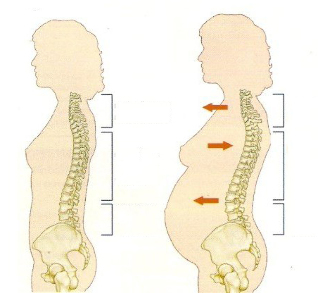
Often, chondrosis of the thoracic region appears during pregnancy or lactation. Often, it all starts during pregnancy, when a woman is experiencing vigorous physical exercise. All of these in conjunction with pregnancy can cause curvature in the thoracic or lumbar region.
During the breastfeeding period, the situation often worsens, because often the mother is in the wrong position for a long time when feeding the baby, they are worn too long on the arm or "rocking". However, during that period, practically no one managed to start the disease beyond level 2.
VSD in osteochondrosis
Osteochondrosis is the cause of the development of vegetative-vascular dystonia. Experts say that VSD is not an independent disease, but the disease is always another problem, which in total can lead to serious consequences.
VSD in this case may appear with incorrect posture during sleep, lack of physical activity and erratic lifestyle, overweight, and so on. As a result of the two diseases, the patient's blood pressure begins to rise, insomnia, numbness in the hands, memory impairment and more.
Osteochondrosis and scoliosis
Scoliosisis a congenital or lateral curvature of the spine. If we talk about congenital scoliosis, then everything is clear. That obtained is interesting in this case, as it most often appears for a reason.
Osteochondrosis of the thoracic spine is often the cause of scoliosis, although the causes may be different. Scoliosis can develop in the third stage of the disease.
Prone Chondrosis
"Spines" is a spinal osteophyte, which is the growth of bone tissue along articular processes or along the vertebrae. They are called thorns because they often look like thorns that grow from the spine on X-rays.
This disease can cause further osteochondrosis. This is the body's natural response, which seeks to increase the area of the vertebrae so that the displacement does not cause much stress. This is the "thorn" that most often causes hardening of cartilage.
Special manifestations of thoracic osteochondrosis in women
The female body is in many respects different from the male, therefore, with this disease, it has a number of characteristics. In women, many autonomic nerve fibers pass through the thoracic region, which enters the limbs and internal organs.
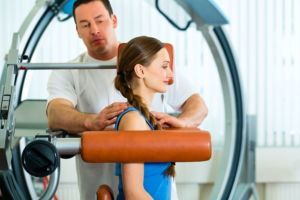
In women, chondrosis has a number of additional symptoms that are often confused by patients.
This includes:
- heart disease;
- abdominal pain;
- pain in the liver area;
- pain in mammary glands;
- numbness or freshness of hands and feet.
Decreased thoracic osteochondrosis
Damage most often occurs in spring and autumn, when weather conditions change dramatically, the body lacks essential vitamins, and human activity increases.
Exacerbations in thoracic osteochondrosis are divided into two types:
- Dorsago.A sharp pain that suddenly appears after a long stay in an uncomfortable position. There is a feeling that the knife pushes towards the patient between the shoulder blades, which is very similar to the symptoms of myocardial infarction. Organized to seek help from a hospital specialist.
- Dorsalgia.Appears gradually and lasts for 2-3 weeks. The pain becomes quite severe and permanent, intensifying with bending, deep breathing or prolonged stay in one position. It passes gradually with exercise and drug treatment.
Irritation is a strong painful sensation that occurs not only when you are in one position for a long time or with a strong load, but simply for no reason. The pain can spread to different parts of the sternum.
What to do in the event of an acute pain attack?
Often, such attacks occur in people who have seen a doctor, have an orthopedic mattress, a corset and know what physiotherapy training is. Those who are unaware of their illness often call an ambulance, which is also a good option.
However, some tips are useful:
- Lie down and try to give maximum rest to the body. When a person is lying down, the pressure on the vertebrae is minimal. It is best to lie on your back or in the position of the fetus.
- Take pain pills if the pain is unbearable.Also see a doctor for recommendations.
- Try to lie as much as possible for the first few days,until the pain subsides.
- Once the pain subsides, you should start waking up more often and do exercise therapy exercises.
How to lower stress with chest chondrosis at home?
It has been said that high blood pressure is a symptom and at the same time a side effect of the disease in question.
If the cause of high blood pressure is osteochondrosis, then you can lower the pressure in the following ways:
- Normalizes blood supply to the brain.For this, there are medications that should be taken periodically on the advice of a doctor.
- Relieves muscle spasms.Regular exercise therapy, as well as massage and physiotherapy can address this.
- Eliminates tissue edema.Physiotherapy, massage and acupuncture are also very effective here.
How and how to treat osteochondrosis of the thoracic region?
Treatment of the disease in question usually takes a long time and involves several procedures. Some can be made yourself at home, and some are only based on expert recommendations. Consider a variety of treatments.
Treatment of breast osteochondrosis at home
Basic home treatment:
- physical therapy training or at least moderate exercise in the morning;
- special mattress;
- simple self-massage techniques;
- herbal baths and swabs to relieve pain and restore blood circulation.
Drugs and medicines
It is important to remember that painkillers and healing are two different things. You should not persist and use painkillers, you should take medication.
WARNING! It is very important to understand that osteochondrosis is a serious disease, therefore it is necessary to take the pill strictly on the recommendation of an expert after a complete diagnosis!
Consider a list of the most popular drug products:
- Pain relievers.Must be taken in case of degradation.
- Hodroprotectors(restores cartilage tissue).
- Injections and injections.It is usually prescribed on the recommendation of a doctor, depending on the stage of the disease and the patient's predisposition to certain medications.
- Ointments and gels.
- Vitamin complex.Any vitamin complex is suitable, it is important to contain vitamin B.
Massage and manual therapy
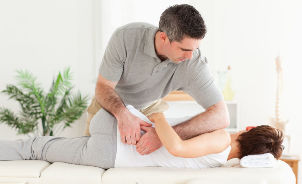
Massage is recommended for all types of osteochondrosis, as it helps relieve tension, pain, restore the nervous system and blood circulation. But it is important to understand that massage should be a therapy.
Manual therapyis a procedure very similar to massage but uses slightly different techniques. Manual therapy is the effect on the anatomical structure of the human body with expert hands, to remove blockages and relax muscles.
The special feature of manual massage is that it can be done in different positions (lying on your back, not on your side, standing or sitting). Often, during pressing, bending, stretching or other techniques, the patient may feel pain, but after the procedure, lightness and "freedom" are always felt.
Acupuncture
Acupuncture is not accessible to everyone, but it is still quite effective. This procedure helps eliminate discomfort, and also initiates the recovery process.
In the early stages, acupuncture can be a major treatment tool, eliminating the need for medication or other procedures to treat breast osteochondrosis.
Physiotherapy
Electrotherapy, magnetotherapy, laser therapy, shock wave therapy, balneotherapy and vibration methods are frequently used.
It is important to note that there are some contraindications to this procedure, so you should consult a specialist.
Physiotherapy and exercise
The main task of physiotherapy training for thoracic osteochondrosis is to strengthen the back muscles, shoulder complex muscles, and even the respiratory muscles. Exercise therapy is recommended to do in special groups, but you can do exercises at home. It is very important to choose exercise for a particular illness and not do exercise during exacerbations.
Let's take a look at some basic exercises:
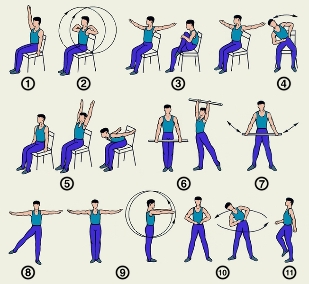
- Sit in a chair, lie on your back and bend your back as much as possible with your hands behind your head(it is important that the thoracic area works). After that, the maximum forward bend is made. Repeat 4-5 times.
- Also, sit on a chair and place your hands behind your head, take a deep breath, and then bend backwards 3-5 times, tilting your upper back to the back.Then repeat the bend forward and exhale slowly 4-6 times.
- Lie on your stomach, bend at the thoracic area as much as possible(but not sharply), trying to lift your head and legs as high as possible. Repeat 5-8 times.
- Stand, hands down, feet together.Raise your hand up at the entrance, then bend backwards. After the arms are lowered while exhaling and the tilt is made forward, you must try to round the buttocks.
There are many back exercises that can help treat illness and are great for prevention or morning exercise.
Most exercises are moderate and are taken from exercise or yoga therapy:
- An effective set of exercises with a stick. A simple set of exercises to help strengthen your back muscles and straighten your spine. The complex includes 5 basic exercises that must be done every day.
- Exercises for osteochondrosis of the thoracic area with protrusion. In this case, it is recommended to do the simplest exercise therapy exercises, which include a back bend in a standing, lying and sitting position.
- Isometric exercises.
Isothermal exercises are rarely used, so let's look at some examples:
- "Karate" training.In a sitting or standing position, arms are bent at the elbows at a 90-degree angle, fingers clasped to the fists, back straight, looking forward. Alternately, each hand hits in front of itself.
- "Ballerina" Exercise. Sitting on a chair, hands locked in front of you at shoulder level. Rotation to the right and left is done alternately to the maximum (do not sharpen). If pain occurs during exercise, it should be stopped.
- Japanese Speech Training. Hands folded in front of you at chest level, palms to palms. Pressure is applied with both hands for 30 seconds. After that, you need an entrance. Place your hands on the edges of the openings and hold them. You do not have to press with your hands anywhere, you just have to bend your hands (as if through an opening) forward, and then backwards.
The author's method of doing gymnastics will help reduce the manifestations of severe symptoms:
- 7 basic exercises by Alexandra Boninafor chest chondrosis.
- Bubnovsky author method.This is a comprehensive treatment for osteochondrosis with the help of special gymnastics, as well as a special unique simulator. According to its creator, the disease can be cured with this method even without medication.
- Gymnastics of cervical cervical chondrosis Dr. Popov.The main difference of this gymnastics is that it does not strengthen large muscles (like most other exercises), but, on the contrary, small ones. This type of gymnastics is also called micro gymnastics.
- Training according to Dr. Shishonin.This method consists of 7 simple but unique exercises that strengthen the muscles of the spine, as well as the chest.
Treatment with folk remedies
Consider the most popular and effective traditional remedies: herbal baths, rubs based on calendula and dandelion, chamomile tincture, as well as tinctures based on lemon balm leaves and orange peel. Often in folk medicine, various strokes are used.
Ficus tincture with butter:
- Cut some ficus leaves and mix with butter in a 1: 1 ratio.
- Then put the mixture in a warm oven for 1. 5 hours, then remove and strain.
- Cooled material should be rubbed along the spine daily.
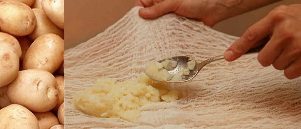
Potato compresses will also be effective for the treatment of osteochondrosis of the chest:
- Take 4-5 potatoes and boil, then crush and turn into a thick paste.
- This subtle is wrapped in several layers of stamps and affixed to the affected part of the spine.
- After that, the compress is covered with a thick woolen scarf or towel, stored until cool.
- When the potatoes are cold, lift the compress and rub the sore spot with alcohol, then lie down under a blanket. Repeat daily before bed until the pain disappears.
Prevention of chest osteochondrosis
Prevention of thoracic osteochondrosis is an active lifestyle, without excessive stress. Proper nutrition, intake of vitamin and mineral complexes, as well as regular medical examinations.
But if we deviate from the general rule, we can distinguish some features:
- Sleep on an orthopedic mattress in a natural position.
- When inactive, work straight back, get up regularly and do warm-ups.
- Morning gymnastics, gym classes, yoga and the like.
Such activities have a positive effect on the spine and the body as a whole, so regular moderate physical activity will help prevent spinal diseases.
In conclusion, let's say that osteochondrosis is a serious disease that must be treated without fail. It is not recommended to treat yourself, especially if the pain is a constant companion. But it should also not be forgotten that prevention is the best treatment, so a healthy lifestyle is the key to success and good health!



































